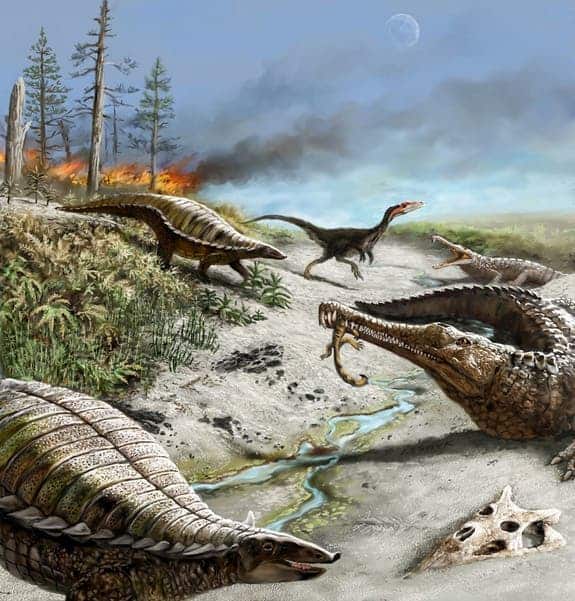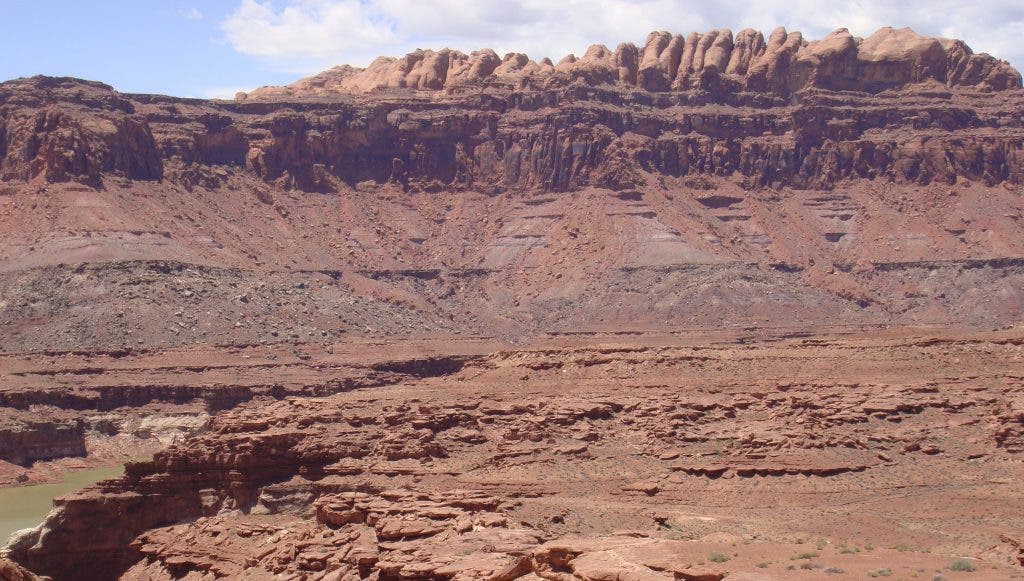Some 30 million years after dinosaurs emerged, they managed to rise up and dominate much of the world – then all clumped together under a supercontinent known as Pangea – except the tropics. Why dinosaurs proved so successful in higher latitudes, but failed miserably in the tropics has perplexed scientists. A possible explanation might be that during those times the tropics had an unpredictable climate, rapidly shifting from wet to dry due to a high concentration of carbon dioxide. This hypothesis is supported by a detailed analysis performed on samples collected at the Ghost Ranch in northern New Mexico, a site rich with fossils from the Late Triassic Period.

The first dinosaurs likely appeared on the surface of what’s today Argentina, then rapidly expanded and migrated across the world where they began to fill or dominate ecological niches. At tropical latitudes, however, this pattern was not recorded as the only fairly successful dinosaurs in the region were the small carnivorous theropods. Big, long-necked dinosaurs, or sauropodomorphs – the dominant plant eating dinosaurs commonly found higher up in latitude – could not be found in any site belonging to tropical latitude Triassic Pangaea. But who could blame them, if we’re to believe Jessica Whiteside, lecturer at the University of Southampton, and her colleagues who found the climate of the time wasn’t at all supportive to large dinosaurs, especially the herbivores.
“Our data suggest it was not a fun place,” says study co-author Randall Irmis, curator of paleontology at the Natural History Museum of Utah and assistant professor at the University of Utah. “It was a time of climate extremes that went back and forth unpredictably and large, warm-blooded dinosaurian herbivores weren’t able to exist nearer to the equator – there was not enough dependable plant food.”

Whiteside went to Ghost Ranch, New Mexico and gathered samples from Chinle Formation rocks, which were deposited by rivers and streams between 205 and 215 million years ago. Back then, Ghost Ranch stood close to the equator at roughly the same latitude as present-day southern India. To reconstruct the ancient climate, the researchers gathered complementary data from fossils, charcoal left by ancient wildfires, and stable isotopes from organic matter and carbonate nodules that formed in ancient soils.
By looking at the fossilized bones, pollen grains and fern spores, the paleontologists could tell which kind of organisms roamed the region and their distribution. For instance, less than 15 percent of the animal vertebrate remains were those of dinosaurs. Instead, reptiles known as Pseudosuchian archosaurs – the lineage that gave rise to crocodiles and alligators – were the most abundant. Differences in abundance of the various types of pollen and fern spores found in between the sediment layers show that there were many rapid shifts in climate. This was confirmed by variations in wildfire burn temperature, which could be estimated by analyzing bits of charcoal recovered in the sediment layers (the amount of light reflected from the fossil charcoal under a light microscope relates directly to the burn temperature of the wood). Changes in the ratio of stable isotopes of carbon in the organic matter bookmarked times when plant productivity declined during extended droughts, but also tell us how carbon dioxide levels climbed from 1,200 parts per million at the base of the sediment section, to about 2,400 parts per million near the top. The immense volumes of CO2 are accounted to the volcanic eruptions, which were at least three times more active than today.
These continuous shifts from stable ecosystem to massive plant die-offs likely prevented the establishment of dinosaur-dominated communities like those across South America, Europe and southern Africa, where aridity and temperatures were less extreme and humidity was consistently higher.
“The conditions would have been something similar to the arid western United States today, although there would have been trees and smaller plants near streams and rivers and forests during humid times,” says Whiteside. “The fluctuating and harsh climate with widespread wild fires meant that only small two-legged carnivorous dinosaurs, such as Coelophysis, could survive.”
The findings published in the Proceedings of the National Academy of Sciences serve as a convincing explanation for an important unsolved puzzle. Yet, they also open a window back in time to an age when the world was fundamentally different from now, climate-wise. At the same time, it’s a world that might cycle back into action with our help. Right now, the CO2 level averaged across the globe numbers over 400 parts per million or three times less the nightmarish climate of the Late Triassic Tropics.
“We show that the climatic effects of increased CO2 significantly reshaped the land plant communities that are at the foundation of terrestrial food webs,” said Whiteside.
“Our data reflect that there are possibly substantial hurdles to human sustainability in the future if we undergo the high CO2 levels predicted to occur in the coming 100-200 years,” she said.






